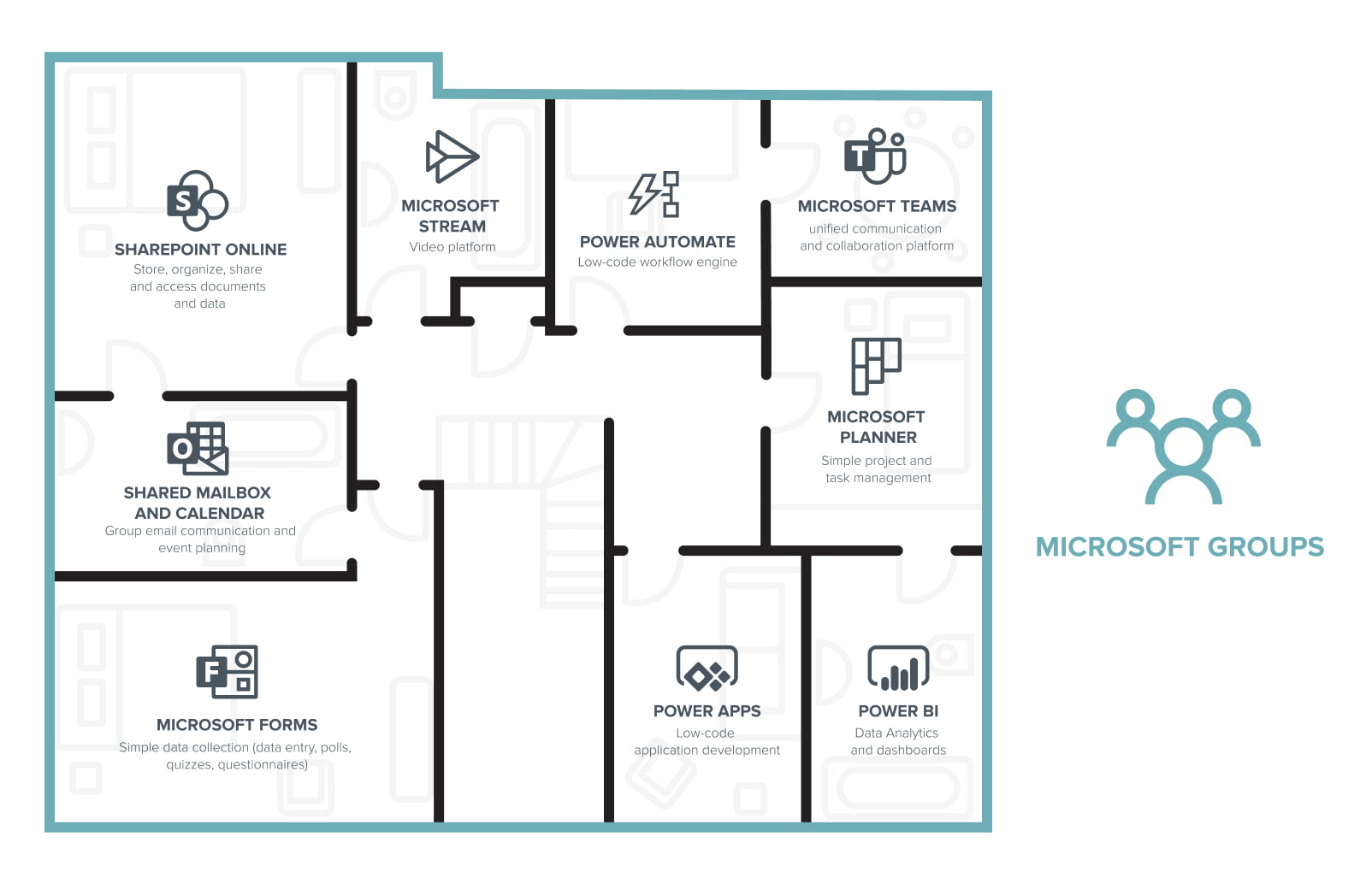A few months ago, COVID-19 changed everything about our world, including the way we work. Everyone who could was thrown headfirst into working remotely.
Although many organizations defied the odds (or at least their traditional ways of working) and rapidly deployed new tools and technology that people needed to work from home, very few fully enabled a new way of working and collaborating.
Historically, rolling out technology that changed the way people communicate and collaborate was a large and expensive project that could last a long time. Then COVID happened and we didn't have a choice. Everyone had to move to new technologies – and fast.
We recently worked with an organization that had a 10-year plan to enable remote working. When COVID hit, they brought it to life in less than a month. Was it all sunshine and rainbows? Absolutely not! But it went much better than any of us expected. In fact, there are endless stories of organizations with 10,000, 20,000 and even 30,000 employees or more that launched Microsoft Teams in less than a month and realized rapid adoption. Which will absolutely make you think, “What was going on pre-COVID that would cause projects to take so long to complete?” After considering my years of experience working in the trenches and then having some great conversations with a few colleagues at Habanero, I started to see a few themes emerge.
The first major change that organizations (including Habanero) seem to be embracing is a more Agile approach. There are literally hundreds of thousands of articles on Agile project methodology, so I’m not going to re-invent the wheel by writing one here, but I will say that Agile, in a very basic way, means move fast, start with solving the most important problems and continuously improve. Taking this approach reduces project scope and duration, which is why the methodology is so popular.
However, it still doesn’t explain why we saw an explosive adoption of Microsoft Teams. For that, we have to dig deeper into understanding the different types of adoption within Microsoft Teams. One type of adoption is explosive, while the other is a slower journey that takes time, education and significantly more change support to shift old ways of collaborating to the new world.
Type 1: Communication and simple collaboration
The reason we saw such a rapid adoption of Microsoft Teams is that people were essentially using technology they were already familiar with. This is not meant to take anything away from Microsoft 365 and their incredible products. We have all kinds of digital tools in our personal lives that are easy to use, such as:
- Instant messaging or text messaging
- Audio or video calling
- Social networks
- Photo/file sharing
It just makes sense that if we were given these types of tools in our workplace (thanks Microsoft!), they would be well adopted. With the rapid adoption of Microsoft Teams, there are now millions of new users worldwide, and it only took a few months to get there. Absolutely incredible!
What we must remember is that while we are seeing great adoption of basic collaboration capabilities, there is an ocean of old-school practices and legacy tools still in play. To truly impact the overall collaboration experience, we can’t just focus on the tip of the iceberg. Organizations need to dig deeper to find all the examples of legacy collaboration and rework them to provide value to employees and streamline their experience into the new paradigm.
Organizations around the world are making massive investments into Microsoft 365, but only scratching the surface (no Microsoft pun intended) of what's possible and realizing the true value of their investment. This brings me to the second type of adoption, advanced collaboration.
Type 2: Advanced collaboration
When we launch an application like Microsoft Teams in 30 days, there is only so much information and training we can cover. We get people up and running with the basics when it comes to communication and simple collaboration, but what comes next?
From Microsoft: Microsoft Teams is a unified communication and collaboration platform that combines persistent workplace chat, video meetings, file storage (including collaboration on files), and application integration. The service integrates with the Microsoft 365 subscription office productivity suite and features extensions that can integrate with non-Microsoft products.
Essentially, the vision of Microsoft Teams is to become the hub for how people collaborate.
Most people don’t know that there are other tools and capabilities that come with a Microsoft Team. In a sense, that is part of what has made Microsoft Teams so successful. It has made it easy and simple to collaborate by storing files and leveraging persistent chat across your Teams. Microsoft Teams is really just a slice of a larger collaboration construct in Microsoft 365 that is anchored by the cross-application service called a Microsoft 365 Group.
Part of the brilliance behind Microsoft’s strategy is how they use Microsoft 365 Groups and the Office Graph to power an interconnected experience across a collection of collaboration capabilities. This gives companies the ability to not just leverage Microsoft Teams, but also connect to tools like:
- SharePoint – Store, organize, share and access documents and data
- A shared mailbox and calendar – Group email communication and event planning
- Microsoft Planner – Simple project and task management
- Microsoft Forms – Simple data collection (data entry, polls, quizzes, questionnaires)
- Microsoft Stream – Video platform
- Power Automate – Low-code workflow engine
- PowerApps – Low-code application development
- Power BI – Data analytics and dashboards
Organizations can enjoy both the simplicity of the basic Microsoft Teams experience and the underlying platform of tools and capabilities that can support complicated business processes and collaboration scenarios.
If you think of a Microsoft 365 Group like a house, its rooms might look something like this:
These are the tools that can help us work in new and exciting ways. It’s the advanced collaboration vision that Microsoft has enabled; we just need to take that next step.It is important to remember that if we really want to impact the entire collaboration experience, we need to tackle the more complicated scenarios that are embedded in legacy platforms, on-premise file shares and antiquated ECM systems, just to name a few.
So, what should we do about all the legacy collaboration scenarios? How do we shift everything to the new world? This is exactly why the second type of adoption is much harder than the first.
This is not something that can happen in a couple of weeks. It’s a process that takes months, if not years! We recommend companies start by getting a handle on the landscape of legacy content, scenarios and processes, so you have an understanding of what’s out there. Then you can prioritize the scope, complexity and value, so that you can start to address advanced solutions in an agile fashion, leading to a system of continuous improvement.
Getting Started
While moving into this phase may sound daunting, these tips will help you get started and move things forward in your organization a little faster:
1. Communicate to your organization the new tools that will become available and their capabilities.
You need to let people that these new tools are coming and/or are here.
Power users will gravitate to these tools as they are always looking for ways to improve business processes using technology. This will really support tip #2!
2. Identify, train, then support your power users.
Previously, these were the co-workers who were the in-house Microsoft Office experts. They could make polls in Outlook, macros in Excel and forms in Word (and yes, we still need them). But now we not only need more of them, we also need to teach them how to build Microsoft Forms, store the data in SharePoint, automate the business processes and approvals using Power Automate and, finally, analyze that data using Power BI (just to name a few of the tools we can use).
We need to identify these users, provide them with the right training and then support them to reduce our technical debt (meaning, give them the time and resources to modernize older processes using Microsoft 365 solutions). We know this type of work can’t fully consume what these people do day-to-day, but it must be more than an off-the-side-of-your-desk approach.
3. Share the stories of success.
Follow that up with real-world examples that demonstrate the modernization of your legacy process using the new capabilities. Build excitement for what is happening.
This will help identify new power users who can be trained and will modernize more legacy processes, giving you more success stories to share. This fosters a cycle of continuous improvement and helps your organization develop a community of knowledge sharing, which brings us to tip #4.
4. Build and support your community.
After you have started this process of continuous improvement, you need to foster it and help it grow. Keep people together through platforms like Yammer and Microsoft Teams, where you can share knowledge learned and support each other.
Then you can have your Digital Workplace and/or IT teams share updates and provide training on what is coming soon from Microsoft 365.
When power users feel happy and supported, that is when real change and adoption with Microsoft 365 becomes sustainable, and organizations begin to realize the true value of their investment.
Long-term considerations
Hopefully these tips will help you start your journey, but remember that journey could take months, if not years. Here are some long-term thoughts to consider:
- Create a team of Microsoft 365 specialists tasked with discovering requirements and shaping solutions.
- Identify areas that are high-value and easy to build (compared to areas that are medium or low value and might take longer to deliver on).
- Build competency in key areas like the Microsoft Power Platform to understand how to bridge workflows and apps into the core Microsoft Teams experience.
- Avoid coding custom solutions unless it’s absolutely necessary.
- Track the portfolio of scenarios and solutions in a backlog and have a support model in place to help maintain and evolve the solutions as the business needs change.
As information workers and the people who support them, we now work in a world where change seems to be happening daily. We have adjusted well and have been doing an incredible job, but we need to keep evolving and improving. It’s up to us as organizations, leaders and subject matter experts to keep learning about the new tools we have access to so we can migrate our legacy processes to a new modern way of working.
We must remember that change takes time, so patience and persistence are key as we push forward. The first type of adoption with communication and simple collaboration within Microsoft 365 can indeed happen very fast, but the second type of adoption involving advanced collaboration takes much longer. Don’t worry, we will get there. We always do.
If you want to discuss adoption and advanced collaboration in Microsoft Teams, please send me an email or reach out to me on LinkedIn or Twitter!





.jpeg?bc=white&la=en&mw=416&modified=20251202191043&hash=E64AA9DFFAE8D1AC27890831F714D5B0FA2FEBB2)

